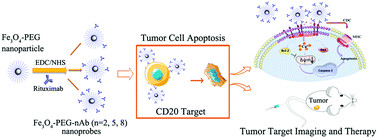当前位置:
X-MOL 学术
›
J. Mater. Chem. B
›
论文详情
Our official English website, www.x-mol.net, welcomes your
feedback! (Note: you will need to create a separate account there.)
Rituximab conjugated iron oxide nanoparticles for targeted imaging and enhanced treatment against CD20-positive lymphoma.
Journal of Materials Chemistry B ( IF 6.1 ) Pub Date : 2020-01-07 , DOI: 10.1039/c9tb02521a Lina Song 1 , Yi Chen 2 , Jiali Ding 3 , Haoan Wu 2 , Wei Zhang 4 , Ming Ma 2 , Fengchao Zang 5 , Zhongqiu Wang 6 , Ning Gu 2 , Yu Zhang 2
Journal of Materials Chemistry B ( IF 6.1 ) Pub Date : 2020-01-07 , DOI: 10.1039/c9tb02521a Lina Song 1 , Yi Chen 2 , Jiali Ding 3 , Haoan Wu 2 , Wei Zhang 4 , Ming Ma 2 , Fengchao Zang 5 , Zhongqiu Wang 6 , Ning Gu 2 , Yu Zhang 2
Affiliation

|
Since its launch in 1997, rituximab (RTX) has extensively improved the treatment of CD20-positive follicular and diffuse large B cell non-Hodgkin lymphoma (NHL). The application of RTX is limited usually by the failed therapy because of resistance. Iron oxide nanomaterials have been explored for cancer detection and treatment in recent years. In this study, a multivalent nanoprobe comprising one Fe3O4 nanoparticle and several RTX antibodies was constructed for the targeted imaging and enhanced treatment of NHL. Poly(ethylene glycol) (PEG)-coated Fe3O4 nanoparticles were fabricated via a thermal decomposition method and ligand exchange. RTX was conjugated onto the surface of the Fe3O4-PEG nanoparticles to form Fe3O4-PEG-nAb (n = 2, 5 or 8) multivalent nanoprobes. These multivalent nanoprobes, with a core size of approximately 11 nm and a hydrodynamic diameter of about 22 nm, showed colloidal stability in buffer solution. The r2 relaxation rate of Fe3O4-PEG-nAb was similar to that of Fe3O4-PEG (309 ± 3.08 mM-1 s-1). The specificity of nanoprobes for CD20-positive Raji cells was assessed on a clinical magnetic resonance imaging scanner. The receptor binding site of one multivalent nanoprobe was more than that of one RTX, exhibiting valence-dependent induction of Raji cell apoptosis, and this effect could be enhanced by complement activation from blood serum added. A similar activity was observed in vivo in a NHL xenograft model. The multivalent nanoprobe treatment significantly reduced tumor burden and enhanced survival in comparison to the RTX group. Our studies demonstrate that the appropriate design and preparation of anticancer antibody-nanoparticle conjugates enable the generation of improved anticancer nanomedicines and could thus provide an efficient cancer theranostic strategy.
中文翻译:

利妥昔单抗缀合的氧化铁纳米粒子用于靶向成像和针对CD20阳性淋巴瘤的增强治疗。
自1997年上市以来,利妥昔单抗(RTX)广泛改善了CD20阳性滤泡性和弥漫性大B细胞非霍奇金淋巴瘤(NHL)的治疗。由于耐药性,RTX的应用通常受到治疗失败的限制。近年来,已经研究了氧化铁纳米材料用于癌症的检测和治疗。在这项研究中,构建了包含一个Fe3O4纳米颗粒和几种RTX抗体的多价纳米探针,用于NHL的靶向成像和增强治疗。通过热分解法和配体交换法制备了聚乙二醇(PEG)包覆的Fe3O4纳米粒子。将RTX共轭到Fe3O4-PEG纳米颗粒的表面上以形成Fe3O4-PEG-nAb(n = 2、5或8)多价纳米探针。这些多价纳米探针 具有约11nm的核尺寸和约22nm的流体力学直径的分子在缓冲溶液中显示出胶体稳定性。Fe3O4-PEG-nAb的r2弛豫速率与Fe3O4-PEG的r2弛豫速率相似(309±3.08 mM-1 s-1)。在临床磁共振成像扫描仪上评估了纳米探针对CD20阳性Raji细胞的特异性。一种多价纳米探针的受体结合位点比一种RTX的受体结合位点多,表现出价依赖性诱导Raji细胞凋亡,这种作用可以通过添加血清中的补体激活来增强。在NHL异种移植模型中,在体内观察到类似的活性。与RTX组相比,多价纳米探针治疗显着降低了肿瘤负担并提高了生存率。
更新日期:2020-02-13
中文翻译:

利妥昔单抗缀合的氧化铁纳米粒子用于靶向成像和针对CD20阳性淋巴瘤的增强治疗。
自1997年上市以来,利妥昔单抗(RTX)广泛改善了CD20阳性滤泡性和弥漫性大B细胞非霍奇金淋巴瘤(NHL)的治疗。由于耐药性,RTX的应用通常受到治疗失败的限制。近年来,已经研究了氧化铁纳米材料用于癌症的检测和治疗。在这项研究中,构建了包含一个Fe3O4纳米颗粒和几种RTX抗体的多价纳米探针,用于NHL的靶向成像和增强治疗。通过热分解法和配体交换法制备了聚乙二醇(PEG)包覆的Fe3O4纳米粒子。将RTX共轭到Fe3O4-PEG纳米颗粒的表面上以形成Fe3O4-PEG-nAb(n = 2、5或8)多价纳米探针。这些多价纳米探针 具有约11nm的核尺寸和约22nm的流体力学直径的分子在缓冲溶液中显示出胶体稳定性。Fe3O4-PEG-nAb的r2弛豫速率与Fe3O4-PEG的r2弛豫速率相似(309±3.08 mM-1 s-1)。在临床磁共振成像扫描仪上评估了纳米探针对CD20阳性Raji细胞的特异性。一种多价纳米探针的受体结合位点比一种RTX的受体结合位点多,表现出价依赖性诱导Raji细胞凋亡,这种作用可以通过添加血清中的补体激活来增强。在NHL异种移植模型中,在体内观察到类似的活性。与RTX组相比,多价纳米探针治疗显着降低了肿瘤负担并提高了生存率。











































 京公网安备 11010802027423号
京公网安备 11010802027423号